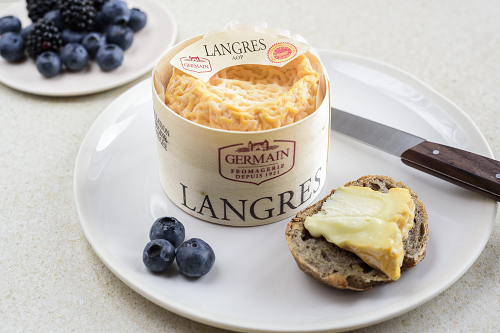Cheese Profile:
This week, we’ll be sharing a special, funky little cheese air shipped to us from France called Langres AOC. Langres is a traditional product from the plateau of Langres in the Champagne region in Northeastern France. The producer, La Fromagerie Germain, is best known for their top caliber production of traditional regional cheeses: Epoisses, Chaource, and Langres, plus a little goat cheese called Pico that you’ll see in fairly wide distribution.
Langres is a cow’s milk cheese washed in a combination of annatto (this is the seed that makes orange cheddar orange) and brine. I’d like to back up a little when I say “washed” – what exactly does this do? In a human sense, washing makes a lot of sense to me. Say, you made a beautiful young cheese from your limited milk supply, you’re waiting for it to age, and it keeps sprouting all of this weird mold that makes you nervous. You don’t want to feed this mold to your family (or your pals at the monastery) so you grab some salt water and wash it off. Fixed!…until it sprouts again so you wash once more. If you keep doing this, this moisture and salt creates a wholly new environment on the cheese, encouraging only certain strains of bacteria that love moisture and salt. Et voila, you’ve invented washed rind cheeses. Their signature calling card? These cheeses smell funky because the chief bacteria (b. linens) that loves this wet, salty environment is, well, a funky-smelling bacteria!
Langres’ is most famous for the little hollow basin that forms on the top of the cheese as the rind shrinks and collapses. Traditionally, peasants would fill this with champagne (remember we’re in the Champagne region…they’re not popping bottles of Veuve Clicquot). I’ve tried this and have to say – okay? Not my go to but the pairing itself is perfect. Creamy washed rind and something bubbly. Langres is a buttery cream bomb that coats your mouth in delicious fat. The acidity and steely bubble of the champagne acts as a counter melody that cuts through that fat brilliantly. In terms of flavor, Langres will feel somewhat similar to a stink bomb like Epoisses but is certainly its more delicate, tame cousin with a melt in your mouth texture that will leave you forgiving its funk.
Please note that the dates are very short on these cheeses. Alas, nothing’s perfect. I’d make sure you eat your Langres this week or weekend. If you forget? No problem at all. These are 100% safe to eat past code. After a week or two out, though, they’ll just start to get a little spicier and funkier.
Fun Fact:
What’s the deal with ash? Ash in and on cheese goes back many centuries. Traditionally, ash would have been casually grabbed from the fire used to heat milk and thrown on curds to protect them from pests, either over a whole cheese like a small goat cheese or over a layer of morning curds as they awaited another layer of evening curds (in the case of Morbier). Ash is no longer pulled from the fire and is instead sourced from highly-vetted cheesemaking supply companies. Because of this, ash has no scent or flavor. Its use is either purely aesthetic / nod to a historical presentation or used functionally in small format goat cheeses with rind development.

